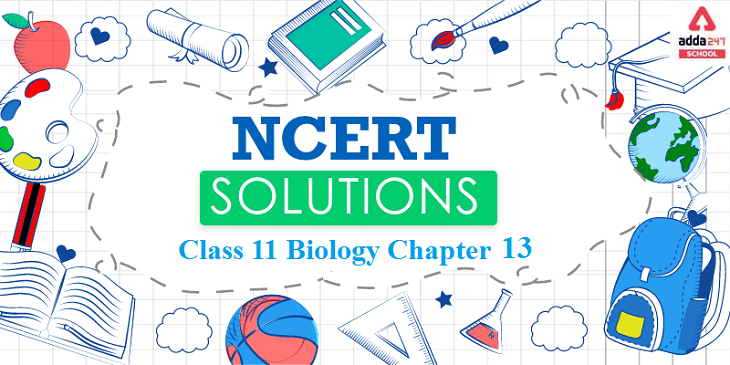Adda 247 provides NCERT Solutions for Class 11 Biology Chapter 13 which is for the students who want to go ahead in life and achieve great marks in their examinations. The NCERT Solutions for class 11 Biology Chapter 13 are provided by the teachers who are experts of their subjects. The solutions are set according to the rules formulated by the NCERT class 11 biology and in the language that can be understood by every student. By reading the solutions students can build up a strong base easily. The NCERT class 11 Biology solutions cover chapters 1 to 22 with the important questions and the answers in a detailed way.
Examinations can be threatening for some people, a proper learning of the concepts is the key to crack the examination. Students rely on the solutions of the NCERT provided by Adda 247. The solutions are formulated by the experts of the subjects who have tremendous knowledge in their subjects.
These NCERT Solutions of class 11 help the students to get familiarized with the textbooks. The students can access the solutions anywhere while browsing the web easily. The solutions are very precise and accurate.
NCERT Solutions for Class 11 Biology Chapter 13 – Photosynthesis in Higher Plants
The chapter provides information about Photosynthesis in Higher plants. All animals including human beings depend on plants for their food. Green plant synthesize the food they need, and for all other organisms depend on them for their needs. Green plants carry out photosynthesis, a physio-chemical processor which they use the light energy to derive the synthesis of organic compounds. The energy required by all living organisms comes directly or indirectly from the sunlight.
Thus, sunlight plays an important role in fixation of CO2 through which, conversion of solar energy into chemical energy takes place. Water plays a significant role during this process.
Hence, photosynthesis is the process by which plants, some bacteria and some protistans uses the energy from sunlight to produce sugar, which through cellular respiration produce ATP, the fuel used by all living organisms.
[sso_enhancement_lead_form_manual title=”Download Full PDF of Class 11 Biology Chapter 13 ” button =”Download Now” pdf =”/jobs/wp-content/uploads/2021/06/18134838/English-chapter-13.pdf”]
Features of the NCERT Solutions for Class 11 Biology Chapter 13 – Photosynthesis in Higher Plants
NCERT Solutions of class 11 have been answered based on the important information on the question.
- The columns are used wherever necessary.
- Solutions are solved point-wise and accurately answered point to point.
NCERT Solutions for Class 11 Biology Chapter 13 – Photosynthesis in Higher Plants Important Questions
Question 1. By looking at a plant externally can you tell whether a plant is C3 or C4 ? Why and how?
Answer: One cannot distinguish whether a plant is C3 or C4 by observing its leaves and other morphological features externally. Unlike C3 plants, the leaves of C4 plants have a special anatomy called Kranz anatomy and this difference can only be observed at the cellular level. For example, although wheat and maize are grasses, wheat is a C3 plant, while maize is a C4 plant.
Question 2. By looking at which internal structure of a plant can you tell whether a plant is C3 or C4 ? Explain.
Answer: The internal structure of the leaves of c4 plants have a special anatomy known as the Kranz
anatomy. This makes them different from the C3 plants. Certain special cells known as the bundle-
sheath cells surround the vascular bundles and are present in several layers. They possess a number of
chloroplasts. They are thick walled cells without intercellular spaces. They are also helpful in gaseous
exchange.
Question 3. Even though a very few cells in a C4 plant carry out the biosynthetic – Calvin pathway, yet they are highly productive. Can you discuss why?
Answer: The productivity of a plant is directly proportional to the rate of photosynthesis which in turn
is dependent on the amount of carbon dioxide present in a plant. In C4 plants a mechanism for
increasing the concentration of carbon dioxide is present. Here, the Calvin cycle occurs in the bundle-
sheath cells. The C4 compound malic acid from the mesophyll cells is broken down inside the bundle-
sheath cells. This causes the release of carbon dioxide gas. The increase in Carbon dioxide gas ensures
that the enzyme RuBisCo does not act as an oxygenase, but as a carboxylase. This prevents losses by
photorespiration thus increasing the rate of photosynthesis. Hence, it can be concluded that even though
a very few cells in a C4 plant carry out the biosynthetic – Calvin pathway, yet they are highly
productive.
Question 4. RuBisCO is an enzyme that acts both as a carboxylase and oxygenase. Why do you think RuBisCO carries out more carboxylation in C4 plants?
Answer: RuBisCO stands for Ribulose Bisphosphate Carboxylase Oxygenase. It is formed by Ribulose bisphosphate (RuBP) which is a five carbon ketose sugar. It is the most abundant enzyme on the earth. The active site on this enzyme can bind competitively to both carbon dioxide and oxygen. The relative concentration of carbon dioxide and oxygen determines which of them will bind to the enzyme. RuBisCO carries out more carboxylation in C4 plants because these plants have a mechanism that increase the concentration of carbon dioxide at the enzyme site. During the C4 pathway, when the C4 acid from the mesophyll cells is broken down in the bundle sheath cells, it releases carbon dioxide which results in the increase of intracellular concentration of carbon dioxide. So, RuBisCO functions as a carboxylase and binds with plants.
Question 5. Suppose there were plants that had a high concentration of Chlorophyll b, but lacked chlorophyll a, would it carry out photosynthesis? Then why do plants have chlorophyll b and other accessory pigments?
Answer: Chlorophyll-a molecules are essential for the process of photosynthesis as they act as antenna molecules. These molecules get excited by absorbing photons and emit electrons during cyclic and non- cyclic photophosphorylation. Chlorophyll a molecules form the reaction centres for both photosystems I and II. Due to these reasons, photosynthesis is absent in plants lacking chlorophyll a. Chlorophyll b, carotenoids and xanthophylls are accessory pigments. The major functions of these pigments are as follows
- Absorption of light rays of different wavelengths and transfer of this energy to reaction centres. 2. Carotenoids and xanthophylls also protect the chlorophyll molecule from photo-oxidation.
Thus, it can be concluded that if any plant were to lack chlorophyll-a and contain a high concentration of chlorophyll-b, then this plant would not undergo photosynthesis.
Question 6. Why is the colour of a leaf kept in the dark frequently yellow, or pale green? Which pigment do you think is more stable?
Answer:
- In the dark, there is no production of chlorophyll.
- Chlorophyll present in the leaf is degraded, thus making the leaf pale green or yellow.
- Carotenoid is a more stable pigment.
Question 7. Look at leaves of the same plant on the shady side and compare it with the leaves on the sunny side. Or, compare the potted plants kept in the sunlight with those in the shade. Which of them has leaves that are darker green ? Why?
- Answer: Light is a limiting factor for photosynthesis. Leaves get lesser light for photosynthesis when they are in shade. Therefore, the leaves or plants in shade perform lesser photosynthesis as compared to the leaves or plants kept in sunlight. In order to increase the rate of photosynthesis, the leaves present in shade have more chlorophyll pigments. This increases the chlorophyll content with increase in the amount of light absorbed by the leaves which increases the rate of photosynthesis. Therefore, the leaves or plants in shade are greener than the leaves for plants kept in the sun.
FAQs Based on NCERT Solutions for Class 11 Biology Chapter 13
What are the advantages of referring NCERT Solutions for class 11 Biology chapter 13?
Students referring the NCERT Solutions of class 11 by Adda 247 find the solutions helpful during the exams. The solutions are prepared by the experts in an interactive manner keeping in mind the students. The students’ perspective is kept in mind while preparing the solutions. It helps in completing the syllabus on time and also provides notes for the revision prior to the exam.
What are the advantages of referring NCERT in competitive exams like JEE and AIPMT?
Most of the competitive exams like NEET, JEE etc. follow the basic NCERT books for designing their question papers. NCERT serves as the base for every book prepared for NEET and JEE. The competitive exams are based on the CBSE syllabus applied in XI and XII classes and NCERT books strictly follow CBSE syllabus. In addition to this, NCERT books play an important role in clearing out the theoretical concepts. Every topic given in NCERT books is explained in such a way to help students make their basics and fundamentals strong and clear.
How to read NCERT books more efficiently?
Given below are the important points which must be followed while reading the NCERT books in an efficient manner:
Go through each topic thoroughly by understanding the meaning and significance of each line mentioned in that particular topic.
Ask your teacher if any doubts.
Note down the important topics to revise at the time of examination.
Solve all the exercise questions given at the end of each chapter. These questions are important for understanding the concepts in a better way.
Is it mandatory to solve all the NCERT questions mentioned at the end of each chapter?
The questions and answers mentioned in NCERT textbooks at the end of each chapter are quite important not only for examination but also for understanding the concepts in a better way. These questions aim to test the students’ understanding and learning over the topics that they have learned in the chapter.
Solving the NCERT exercise problems will help to
- clear all the concepts and formulae you learned in a chapter
- get comfortable with different types of questions that might be asked in exams
- get enough practice which is key to succeed in the Mathematics exam
- improve your accuracy and speed
What are the important concepts covered in Chapter 13 of NCERT Solutions for Class 11 Biology?
The concepts involved in the chapter 9 of NCERT Solutions are –
13.1 – What do we Know?
13.2 – Early Experiments
13.3 – Where does Photosynthesis take place?
13.4 – How many Pigments are involved in Photosynthesis?
13.5 – What is Light Reaction?
13.6 – The Electron Transport
13.7 – Where are the ATP and NADPH Used?
13.8 – The C4 Pathway
13.9 – Photorespiration
13.10 – Factors affecting Photosynthesis
These concepts are created by the faculty at Adda 247. The solutions are available at Adda 247 in PDF format which can be downloaded by the students.









 CBSE Admit Card 2026 for Private & R...
CBSE Admit Card 2026 for Private & R...
 AILET 2026 AIR 1: Check Full Toppers Lis...
AILET 2026 AIR 1: Check Full Toppers Lis...
 AILET Result 2026 OUT, How to Download S...
AILET Result 2026 OUT, How to Download S...














